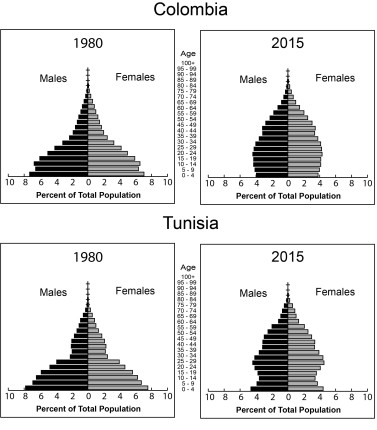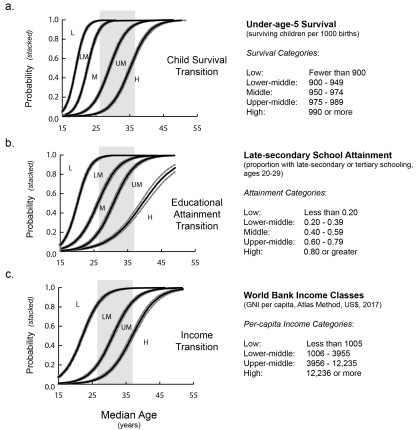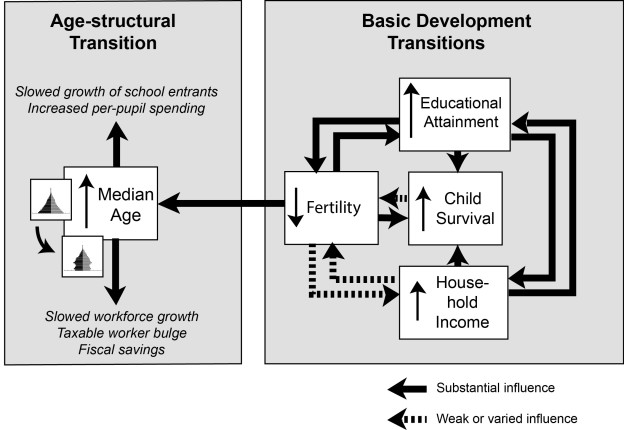-
Does Demographic Change Set the Pace of Development?
December 3, 2018 By Richard Cincotta
The research presented in this article was subsequently published in a peer-reviewed article: https://doi.org/10.1093/acrefore/9780190228637.013.327
This year, 2018, marks the 60th anniversary of a landmark publication by a pair of academic social scientists who first recognized the close relationship between population age structure (the distribution of a country’s population, by age) and development. In Population Growth and Development in Low Income Countries (Princeton U. Press, 1958), demographer Ansley Coale (1917-2002) and economist Edgar M. Hoover (1907-1992) theorized that eventual declines in fertility would transform developing-country age structures. Coale and Hoover demonstrated that these newly transformed age structures would exhibit larger shares of citizens in the working ages, and smaller shares of dependent children and seniors (Fig. 1). This transition, they argued, would someday help lift countries with youthful populations in Asia, Latin America, and Africa out of the low-income bracket.
Sixty years later, data are abundant and evidence supporting Coale and Hoover’s theory is strong. Yet, academic economists and political scientists—whose theories exert a great deal of influence on foreign assistance priorities and development goals—have been slow to accept that progress in the age-structural transition (the shift from very youthful to more mature population distributions) influences the pace of other, more basic development transitions.

Age-structural Timelines
To illustrate how changes in age structure set the pace for other development transitions, we borrowed a model that was developed to forecast political trends for the National Intelligence Council’s (NIC’s) Global Trends publications. By measuring the maturity of age structures using median age (the age of the person for whom one-half of the population is younger) we produced “age-structural timelines” that plot the pace—in terms of median age—of development’s three most basic transitions: child survival, educational attainment, and per-capita income.Age structure timelines differ markedly from historic timelines. On historic timelines, chronological time is generally depicted along a horizontal line (horizontal axis) upon which points and bars mark when an historic event occurred, and how long it endured. Instead of chronological time, age-structural timelines use a horizontal axis that represents the age-structural transition (referred to as “age-structural time”), which ranges from a median age of 15 to 55 years. Currently, the country with the most youthful age structure is Niger, with a median age of about 15 years. Japan, with a median age of 47 years, has the most mature age structure.
The statistical method used to produce age-structural timelines (logistic regression) works with categorical data, rather than individual data points. So, to show the pace of development on age-structural timelines, each of the three basic transitions—child survival, educational attainment, and income—are divided into a series of consecutive categories. For example, the income transition is represented by the World Bank’s low, lower-medium, upper-medium, and high-income categories. Similarly, the child survival transition is divided into five survival categories, and the educational attainment transition into five attainment categories.
Unlike historic timelines, each age-structural timeline is spanned by a series of curves. Each curve shows when—in terms of median age—countries are likely to achieve that category. The next curve (to the right in the series) shows how rapidly, in terms of progress in median age, countries are likely to move into the next higher category (Fig. 2).

Scheduling Development
If age structure did not somehow relate to the pace of any of these three development transitions, no ordered sequence of curves would be apparent. However, each transition’s set of curves does reflect an orderly pattern. Although each pattern differs in slope and spacing, the three transitions share a common feature: As median age advances, countries predictably progress through each transition’s progressive sequence of categories—much like a demographic schedule for development.Another key observation—it’s difficult to behave like a modern state when the age structure is youthful. The graphs show that with a median population age below 25 years, countries are most likely to be in the low or lower-middle levels of development in child survival, educational attainment, and income. For most countries—with the exception of oil and mineral exporters and the least populous countries (mostly island states under 5 million residents)—attaining moderate levels of development (the upper-middle categories) occurs between a median age of 26 and 35 years. During this 10-year slice of age-structural time, countries traverse a “demographic window” of socially and economically favorable age structures that the NIC’s Global Trends has called the intermediate phase of the age-structural transition (shaded in Fig. 2).
Development’s Neglected Demand Side
Does the close relationship between age structure and other key development transitions suggest that policies and investments in education and job growth aren’t important? Or that fertility decline matters the most? Not at all. These results simply echo a conclusion that is common throughout the public health literature: that service-driven achievements in any of the basic transitions—whether child survival, fertility decline, educational attainment, or income—tend to drive demand for other services, spurring progress across several development transitions (see Fig. 3).These results also suggest that demography—the demand side of development—is as essential as the infrastructure that constitutes development’s supply side. Declines in family size produce declines in the size of school-age cohorts, which helps governments, as well as parents, invest more in each child. Moreover, slowed growth among young-adult cohorts reduces job competition and tends to boost the proportion of fully employed.

Reconsidering Demography’s Role
How did Coale and Hoover’s insights into development get lost? Over the six decades since they published their conclusions, development economists and political researchers have focused almost exclusively on development’s supply side: on the institutions, policies, and investments in infrastructure that are key to economic development. That’s not surprising; these have been the central topics of their fields since the end of World War II. However, demography—the demand side of development—was largely ignored by development theorists, relegated to a role of “supporting statistics,” and sidelined even in social science curricula.Then came the Asian tigers and lots more data. In the late1960s and 1970s, fertility declined in a handful of East Asian countries (South Korea, Singapore, Taiwan, Thailand, Hong Kong, and Indonesia), launching them through the age-structural transition. By the mid-1980s, these countries exhibited the favorable characteristics that Coale and Hoover had foreseen: a large worker bulge, and relatively small cohorts of dependent children and seniors—what demographers now call a “demographic dividend.” As those same states began their economic takeoff, demographers turned to reprising (and expanding) Coale and Hoover’s theory.
Most demographers believe that international development agencies are long overdue in acknowledging the role that shifts in population age structure play in social, economic, and political development. Based on current evidence, a realistic reconceptualization would place fertility decline at a key juncture (Fig. 3) linked to improvements in educational attainment and child health and driving the shift to the set of favorable age structures that are associated with the demographic dividend.
Richard Cincotta is a global fellow at the Wilson Center and non-resident fellow at the Stimson Center.Sources: U.S. Department of National Intelligence, UN Population Division, Wittgenstein Centre, World Bank
Photo Credit: UN Secretary General Ban Ki-moon’s Special Lecture for Korean youth. Chungju City Hall, Chungcheong Province, Korea, August 2013. Courtesy of the Korean Culture and Information Service.
Topics: aging, demography, development, economics, featured, Guest Contributor, Infrastructure, security, youth
 A Publication of the Stimson Center.
A Publication of the Stimson Center.










